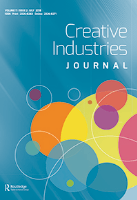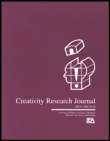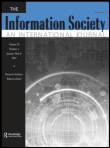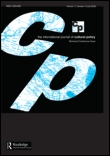
Creative Industries Journal
Scope & Guideline
Exploring the Nexus of Creativity and Commerce
Introduction
Aims and Scopes
- Interdisciplinary Research:
The journal promotes research that crosses traditional disciplinary boundaries, encouraging contributions from fields such as sociology, economics, cultural studies, and technology. - Cultural Economics:
A significant focus on understanding the economic implications of creative activities, including the financial viability of artistic practices and the role of cultural commodities in economic growth. - Social Impact of Creativity:
Exploring how creative industries can address social issues, enhance community engagement, and promote cultural identity. This includes studies on social entrepreneurship and grassroots creativity. - Innovation and Technology in Creative Practices:
Investigating the role of technological advancements and innovative practices in transforming creative industries, including the use of digital platforms and AI in artistic production. - Policy and Governance:
Analyzing the impact of public policies on the creative sectors, including discussions on intellectual property, cultural policy, and support mechanisms for creative entrepreneurs. - Diversity and Inclusion:
Researching issues related to gender, race, and socio-economic inequalities within creative industries, aiming to highlight and address disparities in access and representation.
Trending and Emerging
- Impact of COVID-19 on Creative Industries:
Recent publications have increasingly focused on how the pandemic has reshaped creative practices, economic impacts, and recovery strategies, highlighting the resilience of the sector. - Digital Transformation and Innovation:
There is a growing emphasis on the role of digital technologies, such as AI and blockchain, in transforming creative processes, business models, and audience engagement. - Social Entrepreneurship in Creative Sectors:
Research on social entrepreneurship within creative industries is on the rise, emphasizing how creativity can drive social change and community empowerment. - Sustainability and Ethical Practices:
Emerging themes around sustainability in creative industries reflect a heightened awareness of environmental concerns and ethical practices in production and consumption. - Gender and Diversity Issues:
An increasing number of studies are addressing gender disparities, racial inequalities, and the representation of marginalized groups within creative industries, reflecting broader societal movements for equity.
Declining or Waning
- Traditional Craft Practices:
Although still relevant, the focus on traditional craft practices appears to be waning as newer themes like digital innovation and social entrepreneurship gain traction. - Nostalgic Cultural Analysis:
There seems to be a decline in studies that romanticize past cultural phenomena without critical engagement, as contemporary issues take precedence. - Local vs. Global Dynamics:
Research that primarily contrasts local creative industries against global trends is decreasing, with a growing emphasis on integrated approaches that consider both local and global influences simultaneously. - Static Models of Creative Economy:
The reliance on static models to analyze creative economies is diminishing, as scholars increasingly seek dynamic and evolving frameworks to understand these industries. - Traditional Media Studies:
As digital platforms and new media continue to dominate, traditional studies focused solely on established media forms (like print and broadcast) are becoming less prevalent.
Similar Journals

DIGITAL CREATIVITY
Connecting Disciplines to Illuminate Digital CreativityDIGITAL CREATIVITY, published by Routledge Journals, Taylor & Francis Ltd, is a distinguished academic journal that serves as a vital platform for interdisciplinary research across the realms of Arts and Humanities, Computational Theory and Mathematics, Computer Graphics, and Human-Computer Interaction. Since its inception in 2005, this journal has aimed to explore the intersection of digital technologies and creative practices, making significant contributions to our understanding of digital aesthetics, interactive design, and the evolving nature of creativity in the digital age. With an impressive Q1 ranking in Arts and Humanities and notable standings in related computational fields, DIGITAL CREATIVITY appeals to a diverse audience of researchers, professionals, and students eager to engage with pioneering studies and innovative methodologies. While it presents valuable content primarily through subscription access, its credence in driving forward-thinking discussions is underscored by its ongoing relevance and commitment to advancing knowledge in a rapidly changing digital landscape. Join the conversation and contribute to shaping the future of digital creativity.

Journal of Cultural Economics
Bridging the Gap Between Culture and Economic Theory.Journal of Cultural Economics, published by SPRINGER, stands as a premier platform for the exploration of the relationship between culture and economics. Since its inception in 1977, the journal has continually provided rigorous peer-reviewed articles that delve into the economic dimensions of culture, making significant contributions to the fields of Economics, Econometrics, and Finance. It proudly holds a distinguished position in the research community, evidenced by its Q1 ranking in its category for 2023 and impressive Scopus rank of #38 out of 242, placing it in the top 16% of journals in its field. With an emphasis on interdisciplinary research, the Journal of Cultural Economics publishes articles that foster innovative discussions and insights relevant to researchers, professionals, and students alike. Although it does not offer open access, the journal remains an essential resource for those dedicated to understanding the economic impact of cultural policies, trends, and practices. For more information, contributions, and access to its rich archive, please visit the official SPRINGER website.

International Journal of Management and Economics
Unlocking the Potential of Economic Policies for Effective ManagementInternational Journal of Management and Economics is a distinguished open-access journal published by SCIENDO, dedicated to advancing research in the fields of management and economics. With its ISSN 2299-9701 and E-ISSN 2543-5361, this journal has been a notable platform for scholarly articles since its inception in 2013, aiming to facilitate the dissemination of high-quality research globally. Situated in Warsaw, Poland, the journal seeks to connect researchers, professionals, and students who are eager to explore innovative economic theories, managerial practices, and the implications of various economic policies. With a commitment to open access, the journal not only promotes wide accessibility to its published works but also enhances the visibility and impact of the research it showcases. Contributing authors have the opportunity to engage with a diverse readership while promoting discussions that are pivotal in today’s rapidly evolving economic landscape. As an emerging platform in its field, the International Journal of Management and Economics is becoming a vital resource for anyone interested in the intersection of economic principles and management strategies.

CREATIVITY RESEARCH JOURNAL
Illuminating the Pathways of InnovationCREATIVITY RESEARCH JOURNAL, published by Routledge Journals, Taylor & Francis Ltd, is a pivotal platform in the fields of developmental and educational psychology, visual arts, and performing arts. With a notable impact factor and classification in Q2 for developmental and educational psychology and miscellaneous psychology, and Q1 for visual and performing arts, this journal stands out for its rigorous peer-reviewed articles that foster a deeper understanding of creativity and its multifaceted dimensions. Since its inception in 1988, the journal has significantly contributed to the discourse surrounding creativity, providing valuable insights and research findings that benefit researchers, educators, and practitioners alike. Although it does not operate under an open access model, it remains a highly regarded resource, indexed in Scopus with commendable ranks in various categories, reflecting its influence and relevance in contemporary academic conversation. By bridging gaps between theory and practice, the CREATIVITY RESEARCH JOURNAL aims to inspire innovative thinking in both academic and applied settings, making it essential reading for anyone interested in the dynamic landscape of creativity studies.

POETICS
Charting New Territories in Literary and Social AnalysisPOETICS is a leading academic journal published by Elsevier, focusing on the multidisciplinary fields of Communication, Cultural Studies, Linguistics, Literature and Literary Theory, and Sociology and Political Science. With its esteemed Q1 category rankings across several domains, POETICS showcases cutting-edge research that fosters dialogue and innovation within the arts and social sciences. The journal's commitment to advancing theoretical and empirical understanding of the dynamics between language, culture, and society is evidenced by its impressive Scopus rankings, placing it in the top percentiles among its peers. Covering a wide array of topics, from narrative theory to sociolinguistic analysis, POETICS serves as an indispensable resource for researchers, academics, and students eager to explore the intersection of literature and societal discourse. Situated in the Netherlands, the journal benefits from a rich tradition of scholarly excellence and aims to contribute significantly to the evolving landscape of contemporary research through its ongoing publications until 2024.

INFORMATION SOCIETY
Unveiling the Threads of Culture, Politics, and InformationINFORMATION SOCIETY, published by Taylor & Francis Inc, stands at the forefront of interdisciplinary inquiry, bridging the realms of cultural studies, information systems, and political science since its inception in 1981. With a commendable impact factor and recognized as a Q1 journal in multiple categories, including Cultural Studies and Management Information Systems, it serves as a pivotal platform for researchers, professionals, and students seeking insights into the ever-evolving dynamics of information in society. The journal, indexed by Scopus and ranked highly in various disciplines, not only highlights key theoretical developments but also addresses applied practices in information management within cultural and political contexts. While access is subscription-based, the journal’s impact and relevance ensure it remains essential reading for those engaged in the critical exploration of information's role in contemporary and future societies.

Appalachian Heritage-A Literary Quarterly of the Southern Appalachians
Fostering Dialogue on Culture and CommunityAppalachian Heritage is a distinguished literary quarterly dedicated to exploring the rich cultural tapestry of the Southern Appalachians, published by the University of North Carolina Press. With a focus on literature, folklore, and the arts, this journal serves as a vital platform for scholars, writers, and enthusiasts alike. Through its thoughtfully curated content, Appalachian Heritage not only celebrates the unique voices and stories of this region but also contributes to a broader understanding of Appalachian identity within the greater context of American literature. While the journal operates under traditional access models, its editorial commitment to quality and cultural relevance ensures that it remains an essential resource for those seeking to delve into the literary heritage of the Southern Appalachians. The journal features a blend of academic articles, creative works, and critical essays that engage with themes of place, memory, and community, making it a must-read for anyone invested in the intersection of literature and culture.

Vestnik Sankt-Peterburgskogo Universiteta-Ekonomika-St Petersburg University Journal of Economic Studies
Innovating Economic Discourse for a Dynamic WorldVestnik Sankt-Peterburgskogo Universiteta-Ekonomika-St Petersburg University Journal of Economic Studies, published by ST PETERSBURG UNIV PRESS, is a prominent scholarly journal in the field of economics, econometrics, and finance. With an ISSN of 1026-356X and an E-ISSN of 2542-226X, this journal serves as a vital platform for researchers and professionals looking to explore critical economic theories, quantitative methodologies, and pragmatic approaches to real-world financial issues. As a recognized publication within the Q3 category of Economics in the 2023 rankings, it ranks 159 out of 288 journals, holding a percentile of 44th in the Scopus database. The journal covers a wide array of topics relevant to the field, from economic policy to financial market analysis, enhancing the body of knowledge in the economic landscape. Although an open-access option is not available, the journal’s commitment to advancing economic research from 2019 to 2024 solidifies its importance in shaping academic discourse and fostering interdisciplinary collaboration. This makes it an essential resource for students, educators, and practitioners who seek to remain at the forefront of economic studies.

BULLETIN OF THE COUNCIL FOR RESEARCH IN MUSIC EDUCATION
Elevating Discourse in Music EducationBULLETIN OF THE COUNCIL FOR RESEARCH IN MUSIC EDUCATION, published by UNIV ILLINOIS PRESS, is a premier scholarly journal dedicated to advancing the field of music education through rigorous research and critical discourse. With an ISSN of 0010-9894 and E-ISSN 2162-7223, this journal plays a significant role in disseminating innovative findings and educational practices, ranking in Q1 for Music and Q2 for Education as of 2023. The journal's esteemed position is further highlighted by its Scopus ranking, placing it in the 80th percentile among music-related publications. Covering a time span from 2002 to 2024, it serves as a vital resource for educators, researchers, and graduate students alike. Although the journal does not currently offer open access, its contributions remain crucial in shaping music education research and practice. The BULLETIN not only inspires scholarly inquiry but also enhances the discourse surrounding effective music education methodologies.

International Journal of Cultural Policy
Championing Scholarly Excellence in Cultural StudiesThe International Journal of Cultural Policy, published by Routledge Journals, Taylor & Francis Ltd, is a prestigious platform dedicated to advancing scholarship in the fields of cultural studies and sociology, establishing itself as a leading resource for researchers, professionals, and students engaged in exploring the intersection of culture, policy, and society. Since its inception in 1997, the journal has consistently achieved high-impact standings, currently classified in the Q1 category for both Cultural Studies and Sociology and Political Science, making it essential reading for those interested in the nuances of cultural governance and policy-making. With a remarkable Scopus rank placing it in the top percentile of related journals, it facilitates the dissemination of innovative research that tackles contemporary cultural challenges. While the journal is not open access, it remains an invaluable resource, offering a rich archive of theoretical and empirical studies critical for understanding the dynamic interplay of culture and policy across varied contexts. We highly recommend it for those seeking to enhance their knowledge and contribution to this vibrant field of study.